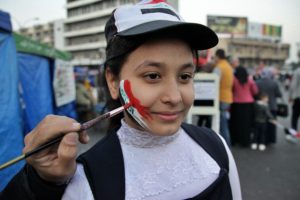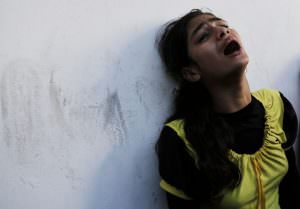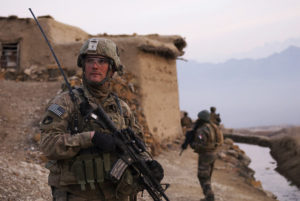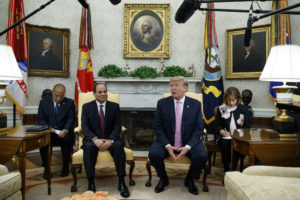Dispatches From Cairo: Game of Death
Oh, Egypt Oh, Arab Spring Another tailspin into the worst of expectations and reactions leaves us in a gray confusion of deception and distrust Now, there is gore on stadium seats Another tailspin into the worst of expectations and reactions.
We asked Lauren Unger-Geoffroy, an international artist who lives in Cairo, to share her perspective of life in Egypt after the revolution. In this entry, amid breaking news and ongoing violence, she writes about Egypt’s stunned reaction to a soccer riot that killed scores of fans.
CAIRO — Oh, Egypt. Oh, Arab Spring. Another tailspin into the worst of expectations and reactions, the worst of reactionary strategies, the no-plan of emotional and boiling resistance, leaves us in a gray confusion of deception and distrust, with the young revolution holding a single, understandable focus in fury: Get out! Get out!
We have been in shock since Wednesday when the boldly rebellious and prone-to-violence “Ultras” — a national collection of fan clubs supporting clashing football [soccer] teams that has been at the front line of the revolution — fell into the easy trap of their own tendencies. Against a backdrop of past, frequent scuffles between opposing fans, the stage was set for a tragedy.
Now, there is gore on stadium seats, and post-riot images include a blood-soaked Reebok shoe lying against the fence, its lace trailing.
Seventy-six people were killed in 15 minutes at a football match, many of them innocent teenagers. More than a thousand were injured. A TV announcer yelled in horror “Oh God! What are they doing!” as thousands among the 20,000 Ultra fans of the Masry team, the winning team, incomprehensibly rushed the field after the final goal and chased and attacked the losing team, Cairo’s el Ahly, and its 2,000 Ultras and regular supporters. Many in the stadium rushed down to the field, either in panic or to participate in the mayhem. People were trampled and heads were smashed, people were stabbed. The lights went out. The TV announcer was shrieking and sobbing. Minutes before this insane violence started, the massive crowd had been chanting in unison “Down with the military regime!”
At the same time this was transpiring at Port Said Stadium, a football match at Cairo International Stadium was halted and somehow the structure caught on fire. In that case, no deaths were reported.
* * *
The facts are these:
1. Port Said Stadium security personnel, who hold a grudge against the Ultras, did not keep out thugs who entered the stadium with bludgeons and knives and fireworks. Many Egyptians believe these thugs to have been hirelings of the government, men paid to create a distraction to bolster the agenda of military authorities.
2. The security people did not intervene when the Ultras rushed the field and began attacking the visiting Ahly team and its Ultra supporters, who some months ago trashed the Port Said Stadium.
3. Innocent spectators who could not escape were mowed down.
4. Security had padlocked a fence, preventing pursued spectators from escaping.
5. Stadium lights were turned off at the peak of the violence.
Doctors say most of the deaths and severe injuries in the riot were caused by concussions, cuts and suffocation.
The Ahly team and some of its supporters ended up barricaded in the team’s media room and locker room. TV spectators heard one player screaming, “Another guy just died in front of me in here!”
Across the country, Egyptians were in shock and sickened.
Call-in lines were set up for people to find out if relatives had survived the violence. A mother was on TV as she phoned from the Cairo train station, where she waited with thousands of others for the train returning from Port Said. When the names of the dead were announced, she heard that of her 17-year-old son. Her screams and sobs were heart-wrenching. Many of us wept throughout the night.
One military spokesman said, “We could not intervene, that was the job of the minister of the interior CSF [Central Security Forces]. We don’t want any confrontations with the people.”
It all stinks. All of the purported causes and conspiracy theories are sickening. There were more people killed last Wednesday night than in the worst night of the revolution.
In the three days after the riot, and since the first anniversary of the revolution’s terrible Jan. 28, 2011, a rare wave of crime occurred in Cairo — five bank robberies (one armored car), almost unheard of in Egypt; four kidnappings; three shootings. All so uncharacteristic and oddly clumped.
Egyptians are divided into those disgusted with the uncontrolled violence of the football fans and those whose anger is directed at the source of ongoing public frustration: the Supreme Council of the Armed Forces (SCAF). Fifty-one people were eventually arrested in the stadium violence, and most Egyptians agree that the security personnel behaved poorly. An investigation is under way. Theories among the public about the cause of the bloodletting vary, but most center on the SCAF.
Thousands massed till 4 a.m. at the train station in Cairo to await the dead and the injured and other survivors returning from Port Said, and they marched the following day to Tahrir Square and the Ministry of the Interior. Many others sympathizing with them and frustrated with the regime’s suspected continued dissimulation and manipulation joined their number. There were similar demonstrations in Alexandria, Suez — all over Egypt. Once again, the people were in the street, in rage and armed with rocks, faces covered with gas masks in preparation for the confrontation they were itching for.
For some time now, on social networks and signs and in graffiti, many young men have been expressing a desire for martyrdom. It is a cultural phenomenon one must understand. Being a martyr, dying for a cause, is an honor. It is heroic. Life has no future, and martyrs are heroes revered and immortalized in media, on walls, in images for all the people, for history. Their families will be sad over their loss but honored. Heaven is assured for heroes.
Thus it was with leaden hearts that Egyptians expected the worst in the riot’s aftermath.Recent days have been clouded by tear gas clinging to battered streets where police and the people battle. People choking, throwing up, throwing rocks, ferrying the injured on motorcycles to quickly established field hospitals. A Twitter-organized volunteer system of food and blanket delivery snapped back into function with practiced efficiency.
Helmeted members of the CSF have been out in large numbers, notably armed with a new supply of USA-made tear gas stamped “March 2011.” A huge reserve of expired canisters of U.S. tear gas had impressively been used up in the previous months.
The people have heaved down a part of the cement-block wall erected by the military to protect the Ministry of the Interior. Protesters are still there working out their anger as I write this, but the overwhelming sentiment of Egyptians since Wednesday is depression.
As of this moment, in all of Egypt there have been fewer than 20 reported deaths in protest-related violence since the outrage at the stadium. It seems a light number to us. Some of the revolution’s dead were boys who had desired martyrdom, their images now gracing marches and squares in the swelling ranks of martyr-heroes, but this new massacre didn’t work that way. Recently, we have seen photos of positive, beaming teenagers and other young people happily attending a major football match, some for the first time. Their Facebook pages, full of innocent enthusiasm, also bear witness to the hollow loss of their futures.
Friday’s sermon in my neighborhood was triste. The voice of our dramatic imam was weak with despair. “Why?” he asked. “We must fight for our dignity,” he cried. “How can we be made to kill each other? These thugs killed their brothers! And were they paid 100 guineas?”
The atrocity at the stadium indeed worked to the advantage of the SCAF if the authorities instigated it in an effort to turn the people away from focusing on the longtime privilege of Egypt’s elite. The budget of the military makes up 30 percent of the gross national budget, and the SCAF’s favored sons hold vast industries and other properties in a country where most inhabitants are poor, unskilled and illiterate. It has never been difficult to spin the common people in circles, and it does not require plans of excessive cleverness (although these plans now sometimes backfire under the scrutiny of Internet-aware young people).
The nation’s parliament of fledgling legislators has set special meetings on Wednesday’s sad events. The usual suspects are being called out. Meanwhile, a people shamed by seemingly senseless violence are striking back against the boogeymen they know: the SCAF, mysterious third parties, “Mubarak’s Children” felool (leftovers). It is a dreary continuation of mobilization without foresight.
And as Egypt held much of the world’s attention over the last week, forces of Syrian President Bashar Assad slaughtered hundreds of his own people in the Arab Spring’s most horrific massacre yet. In Homs, whole families were murdered, children beheaded. Rockets landed on the anti-government neighborhood of Al-Khalidiyeh.
Even Egyptians caught up in their own troubles were stopped in place as the news from Syria flew on Twitter in real time. Across the world, demonstrators attacked a number of Syrian embassies. Among them was the one in Egypt, where the assault was led by Egyptians and Syrians who will not accept the slaughter of their brothers.
Blankets and other supplies flow through the revolutionaries’ volunteer stations to multiple fronts now. The people want an end to the military regimes in both Egypt and Syria regardless of what is inside the regimes’ black boxes. They want an end to Assad and his butchering of a Syrian opposition they support. They want freedom, bread and dignity. They want to tear it all down.
There are people and tents and empty tear-gas canisters and rubble in the acrid haze of Mohammed Mahmoud Street in front of the Ministry of the Interior. The people still shout hoarsely for the death of Field Marshal Mohamed Hussein Tantawi. There are effigies and signs and the occasional Molotov cocktail sailing through the air to explode in fire.
Saturday was the Prophet’s Birthday. It is not supposed to be a religious or largely observed holiday. Usually people give each other sweets, and children get penny toys. My neighbor gave me a bag of halwa and other candies, but most people didn’t even notice the holiday this year, as distracted as they were by the grimness of the current wave. I remember last year’s Melad (Prophet’s Birthday). The revolution was still in the passionate uproar of its beginnings … and the neighborhood’s kids were smiling from a sugar rush.
But the news of the day was not all bad. Two American female tourists who were kidnapped in Sinai Egypt last week were returned safely Saturday and reported that they had not been harmed. They said they were treated “like family” by their Bedouin kidnappers, with whose relatives they shared pleasant dinners. They are continuing their vacation.
We are praying that all the people will be delivered from their devils and that somewhere in this chaos someone will remember to ask the right questions, and show the way, and not get swept up, and survive long enough for the people to understand and follow.
After the prayers are done, in my head I still see the Facebook pages of two smiling 15-year-olds who died after attending their first major football game; I still hear the mother of a dead 17-year-old sobbing at a train station. And in the physical world I still hear the sounds of tear-gas guns reverberating in the street. …
Happy Prophet’s Birthday to you.
Your support matters…Independent journalism is under threat and overshadowed by heavily funded mainstream media.
You can help level the playing field. Become a member.
Your tax-deductible contribution keeps us digging beneath the headlines to give you thought-provoking, investigative reporting and analysis that unearths what's really happening- without compromise.
Give today to support our courageous, independent journalists.









You need to be a supporter to comment.
There are currently no responses to this article.
Be the first to respond.